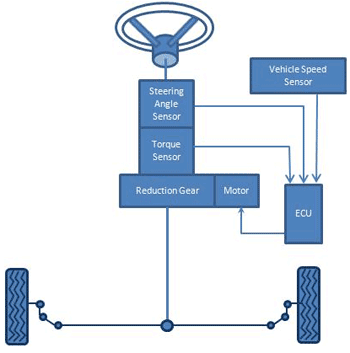Electronic Power Steering
- Basic Description
-

Power steering systems supplement the torque that the driver applies to the steering wheel. Traditional power steering systems are hydraulic systems, but electric power steering (EPS) is becoming much more common. EPS eliminates many HPS components such as the pump, hoses, fluid, drive belt, and pulley. For this reason, electric steering systems tend to be smaller and lighter than hydraulic systems.
EPS systems have variable power assist, which provides more assistance at lower vehicle speeds and less assistance at higher speeds. They do not require any significant power to operate when no steering assistance is required. For this reason, they are more energy efficient than hydraulic systems.
How the system works:
- The EPS electronic control unit (ECU) calculates the assisting power needed based on the torque being applied to the steering wheel by the driver, the steering wheel position and the vehicle’s speed.
- The EPS motor rotates a steering gear with an applied force that reduces the torque required from the driver.
There are four forms of EPS based on the position of the assist motor. They are the column assist type (C-EPS), the pinion assist type (P-EPS), the direct drive type (D-EPS) and the rack assist type (R-EPS). The C-EPS type has a power assist unit, torque sensor, and controller all connected to the steering column. In the P-EPS system, the power assist unit is connected to the steering gear's pinion shaft. This type of system works well in small cars. The D-EPS system has low inertia and friction because the steering gear and assist unit are a single unit. The R-EPS type has the assist unit connected to the steering gear. R-EPS systems can be used on mid- to full-sized vehicles due to their relatively low inertia from high reduction gear ratios.
Unlike a hydraulic power steering system that continuously drives a hydraulic pump, the efficiency advantage of an EPS system is that it powers the EPS motor only when necessary. This results in reduced vehicle fuel consumption compared to the same vehicle with an HPS system. These systems can be tuned by simply modifying the software controlling the ECU. This provides a unique and cost effective opportunity to adjust the steering "feel" to suit the automotive model class. An additional advantage of EPS is its ability to compensate for one-sided forces such as a flat tire. It is also capable of steering in emergency maneuvers in conjunction with the electronic stability control.
In current-day systems, there is always a mechanical connection between the steering wheel and the steering gear. For safety reasons, it is important that a failure in the electronics never result in a situation where the motor prevents the driver from steering the vehicle. EPS systems incorporate fail-safe mechanisms that disconnect power from the motor in the event that a problem with the ECU is detected.
The next step in electronic steering is to remove the mechanical linkage to the steering wheel and convert to pure electronically controlled steering, which is referred to as steer-by-wire. This functions by transmitting digital signals to one or more remote electric motors instead of a rack and pinion assembly, which in-turn steers the vehicle. While it has been used in electric forklifts and some tractors, as well as a handful of concept cars, the 2014 Infinity Q50 was the first commercial vehicle to implement steer-by-wire. Although there is normally no direct mechanical linkage, the Q50 has a mechanical back-up. In the event that a problem is detected with the electronic controls, a clutch engages to restore the driver's mechanical control. As with throttle control systems, it is likely that steer-by-wire will become the standard once the electronic controls prove to be safer and more reliable than the current hybrid systems.
- Sensors
- Steering wheel torque sensor, steering wheel position sensor, wheel speed sensor
- Actuators
- Electric motor
- Data Communications
- CAN bus data communication between EPS and engine controller
- Manufacturers
- Bosch,
Denso, Hella, JTEKT, Kobelt, Koyo, Mitsubishi Electric, Nexteer, NSK, Preh, Showa, TRW,
ZF
- For More Information
- [1] Power Steering, Wikipedia.
- [2] Electric Power Steering (EPS), Freescale web site.
- [3] Electric Power Steering, www.aa1car.com.
- [4] Research Analysis: A Review of Electric Power Steering Systems, Matthew Beecham, Just-auto.com,
Aug. 6, 2007.
- [5] BMW Electric Power Steering EPS, YouTube,
Nov. 21, 2008.
- [6] Hyundai Power Steering (MDPS), YouTube,
July 15, 2009.
- [7] Are We Losing Touch? A Comprehensive Comparison Test of Electric and Hydraulic Steering Assist, Car and Driver, Jan. 2012.
- [8] Nissan Introduces Fly-by-Wire Independent Steering Control Technology, YouTube, Oct. 17, 2012.
- [9] Electric Power Assist Steering from Ford Motor Company, YouTube, Mar. 14, 2013.
- [10] Top Tech Cars 2013: Infiniti Q50, Lawrence Ulrich, IEEE Spectrum, Mar. 29, 2013.
- [11] Car Tech 101: Power Steering Explained, YouTube,
Apr. 1, 2014.
|

